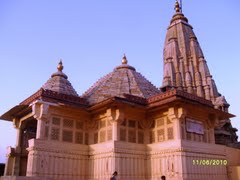Raja Sawai Jai Singh, the founder of Jaipur built the temple of
Kalki in 1727 AD at the time he was building the city. He was a keen student of
Vedic texts and a Hindu revivalist. Jai Singh built the Kalki temple right
opposite the eastern entrance to the City Palace. The location of the temple
was important but still it was not given a prime position in the street. The
temple was built behind the street of impressive buildings. The temple can be
entered through a ceremonial archway in two easy slopes through a ramp way
rather than a staircase that opens at the street.
The temple is built over a 20
feet high plinth. There is a ramp within the temple complex leading up to the
temple. A canopied kiosk in one corner contains the fine marble statue of a
horse facing the temple, which is supposedly the mount of Kalki. The ramps are
probably constructed to facilitate the horse to climb up and down easily.
Historians also believe that Jai Singh was the last Hindu ruler to have
performed Ashwamedha Yajna, an ancient Vedic rite and the horse was sculpted to
commemorate the event.
The temple is constructed of stone in typical style of temple
architecture of North India. The only exceptional feature in the temple is that
it has two sikhars instead of one. The smaller sikhar at the back is called the Lakshmi Niwas, the abode of Goddess Lakshmi. It was constructed to build the
idol of Padmawati Devi. The statue, however, is kept with that of Kalki under
the main sikhar.
The temple is close ever since it was built waiting for the
birth of the Lord Kalki. A caretaker priest appointed by the state government
looks after the cleanliness of the temple and opens it periodically.
The Kalki Temple at Jaipur is the only temple in India dedicated
to the incarnation of God not yet born. Kalki avatar is took by Lord Vishnu to
destroy and defeat evil forces on earth. Kalki who is said to bring an end to
the darkness of the kali yuga by destroying evil and sin and beginning a new
yuga called Satya Yuga of sinlessness and peace. Kalki will reign on earth for 1000 years as the king of Shambhala.
According to Hindu mythology, Kalki is the
tenth and the last incarnation of the Lord Vishnu who is yet to born. Kalki
literally means Born of Time. Lord Kalki is believed to come on a white horse
with a shinning sword in his hand and protect the mankind from prevailing chaos
and confusion in Kal Yuga. Kalki Temple Jaipur. The temple is constructed
opposite to the eastern gate of the palace of jaipur which opens to the sireh
deori bazaar where the Hawa Mahal is located.
The unique feature of the temple
is that it has two shikhar instead of two, the taller one contains the statue
of Lord Kalki and Padmawati Devi. Since the God has not yet come, it was
natural that traditionally no temples were consecrated especially for Kalki.
However, there is one Kalki temple in the walled, pink city of Jaipur.
Kalki Temple, Tulsi Marg, Badi Chaupar, Jaipur, Rajasthan
302002, India.
Do:
- Do pray your Ishta Devata before pilgrimage to Temple.
- Do contact Temple Devasthanam information centre for enquiry, temple information and for Pooja details etc.
- Do reserve your travel and accommodation at Temple well in advance.
- Do bath and wear clean clothes before you enter the temple.
- Do concentrate on God and Goddess inside the temple.
- Do maintain silence and recite your Istamantram to yourself inside the temple.
- Do observe ancient custom and traditions while in Temple.
- Do respect religious sentiments at Temple.Do deposit your offerings in the hundi only.
Don't s:
- Do not come to Temple for any purpose other than worshipping of God and Goddess.
- Do not smoke at Temple.
- Do not consume alcoholic drinks at Temple.
- Do not eat non-vegetarian food in the Kshetram.
- Do not approach mediators for quick Darshanam. It may cause inconvenient to others.
- Do not carry any weapon inside the temple.
- Do not wear any head guards like helmets, caps, turbans and hats inside the temple premises.
- Do not perform Sastanga Pranama inside the Sanctum Sanctorum.
- Do not take much time while performing Sparsa Darshanam to God in Garbhagriha.
- Do not buy spurious prasadams from street vendors.
- Do not encourage beggars at Temple.
- Do not spit or create nuisance in the premises of the temple.
